- Inorganic and Analytical Chemistry
- Coordination Chemistry(Sakai Lab.)
- Physical Coordination Chemistry(Ohba Lab.)
- Bioanalytical Chemistry(Matsumori Lab.)
- Spectrochemistry(Onda Lab.)
- Inorganic Reaction Chemistry(Utsunomiya Lab.)
- Physical Chemistry
- Physical Chemistry of Soft-matters(Annaka Lab.)
- Theoretical Chemistry(Nakano Lab.)
- Quantum Chemistry(Terasaki Lab.)
- Structural Chemistry(Ohashi Lab.)
- Photo Physical Chemistry(Hiramatsu Lab.)
- Organic Chemistry and Biochemistry
- Molecular Catalysis Chemistry(Tokunaga Lab.)
- Bioorganic Chemistry(Oishi Lab.)
- Dynamic Chemical Life Science(Hori Lab.)
- Chemical Physics and Biophysics(Akiyama Lab.)
- Structure-Function Biochemistry(Matsushima Lab.)
- Bioanalytical Chemistry(Matsumori Lab.)
- Cooperation Group - Institute for Materials Chemistry and Engeneering
- Soft Interfacial Chemistry(Takiue Lab.)
- Biomolecular Chemistry(Nose Lab.)
- Synthetic Organic Chemistry(Uchida Lab.)
- Nanophysical Chemistry(Tamada Lab.)
- Cooperation Group - Faculty of Arts and Science
- Photofunctional Materials Chemistry(Sato Lab.)
- Nanofunctional Chemistry(Yamauchi Lab.)
- Structural Organic Chemistry(Tani Lab.)
- Cooperation Group - Central Institute of Radioisotope Science and Safety Management
- Radiochemistry (Tachibana Lab.)
- Cooperation Group - Institute for Advanced Study
- Biocatalysis Chemistry(Ushimaru Lab.)
Research Groups
Inorganic and Analytical Chemistry
Coordination Chemistry(Sakai Lab.)
Our group focuses on the realization of artificial photosynthetic molecular systems driving splitting of water (H2O) into H2 and O2 with use of solar energy (2H2O + 4hν → 2H2 + O2). With this aim, we have performed the design and synthesis of new molecular catalysts based on metal complexes that can promote both water reduction and water oxidation processes in high turnover frequencies with lower applied overpotentials. In order to realize the hydrogen society, development of such fast catalysts that can function with low overpotentials is crucial in minimizing the input energy to drive the overall water splitting processes. This approach is directed to expand the wavelength range used for solar water splitting to a wider range that extends to a lower energy region of solar spectrum. Thus, our group targets development of new molecular catalysts that drive both water oxidation and reduction with a lower applied overpotentials. For their wide spread practical use in the future, catalyst development using cheap abundant non-precious metals, such as Fe, Cu, Ni, Co, etc., is also targeted in these studies. Improvement in the photoinduced electron transfer processes that generate reducing and oxidizing equivalents from solar light absorption is also targeted.
Staff
- Ken Sakai (Professor)
- Hironobu Ozawa (Associate Prof.)
- Yoshihiro Okaue (Lecturer)
- Kosei Yamauchi (Assistant Prof.)
Main research topics
- Synthesis and functional evaluation of molecular catalysts driving oxygen production reactions
- Synthesis and functional evaluation of molecular catalysts for hydrogen production reaction
- Synthesis and functional evaluation of molecular catalysts that drive the reduction of carbon dioxide
- Synthesis and functional evaluation of molecular photosensitizers for effective use of sunlight
- Development and functional evaluation of molecular systems that drive artificial photosynthetic reactions
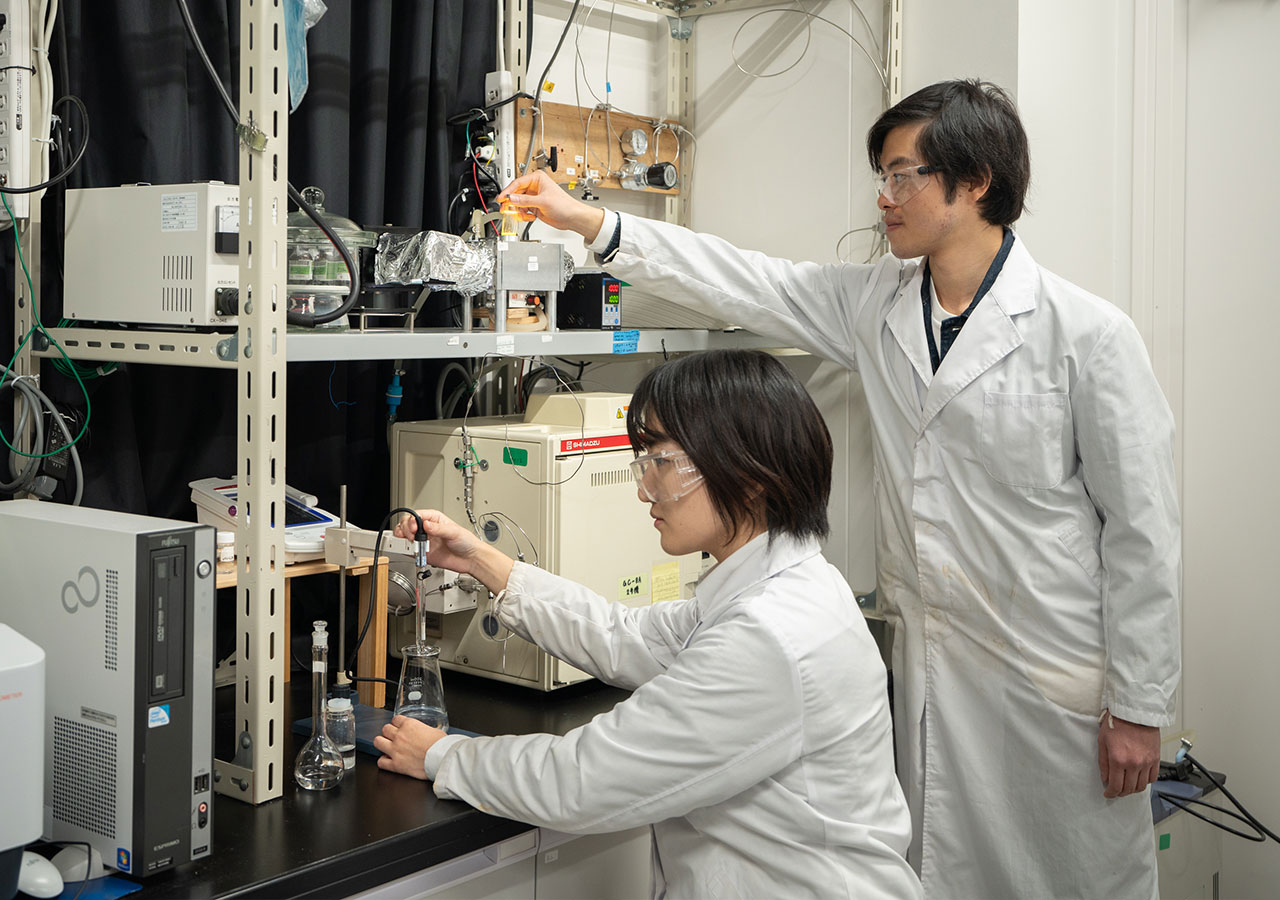
Physical Coordination Chemistry(Ohba Lab.)
In the field of molecular materials, one of the important targets is the development of multi-functional material combining different properties and functions in a synergic way. Our group focuses on “coordination polymers” and “liposome” as a meso-scale platform for interlocking various functions and properties. The coordination polymers can provide functional space that consists of flexible, highly ordered and designable frameworks based on coordination bonds. The frameworks can be incorporated magnetic, electrical, optical and other properties, and also can adsorb molecules in the void of structure. The liposome, a spherical vesicle composed of a phospholipid bilayer, provides hierarchical composite with selectively incorporating different functional molecules into the hydrophilic inner water phase, hydrophobic lipid bilayer, and inner and outer surfaces. We are exploring advanced functions using such spaces with synergically linking plural different properties of components.
Staff
- Masaaki Ohba (Professor)
- Ryo Ohtani (Associate Prof.)
- Benjamin Le Ouay (Assistant Prof.)
Main research topics
- Development of functional (magnetic, luminescent, molecular sensing) metal-organic structures (MOFs)
- Development of spin Qubit using metal complex molecules
- Development of ferroelectric materials and solid-state electrolytes based on metal complexes
- Development of metal-organic polyhedra (MOPs) integrated with enzyme immobilization methods
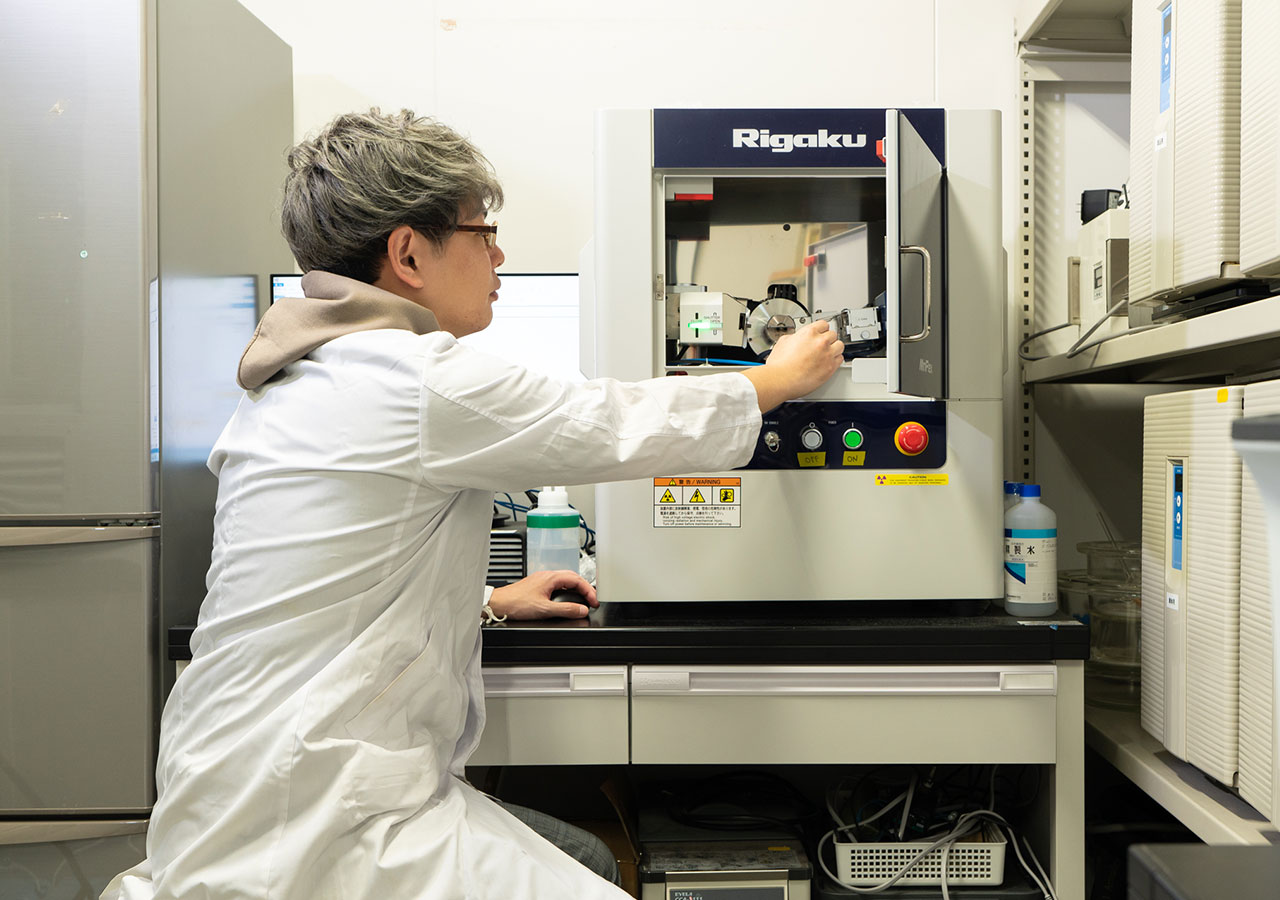
Bioanalytical Chemistry(Matsumori Lab.)
We are studying biomembranes including membrane proteins using various analytical methods. The purposes of our study are to gain deeper understandings of biological membranes themselves, as well as to elucidate the molecular mode of actions of membrane-associated drugs and the pathogenic mechanism of membrane-related diseases such as Alzheimer disease.
Staff
- Nobuaki Matsumori (Professor)
- Takayuki Kawai (Associate Prof.)
- Kohei Torikai (Lecturer)
- Chenchen Liu (Project Assistant Prof.)
Main research topics
- Elucidation of the mechanism of action of anesthetics and natural organic compounds based on inhibition/promotion analysis of lipid rafts
- Elucidation of the mechanism of action of bioactive lipids and natural organic compounds such as ceramide and DHA
- Development of novel methods and probes for interaction analysis of lipids and membrane proteins
- Development of novel analytical methods to evaluate molecular dynamics of lipid membranes
- Development of ultra-sensitive and comprehensive bioanalytical methods using capillary electrophoresis for medical and drug discovery applications
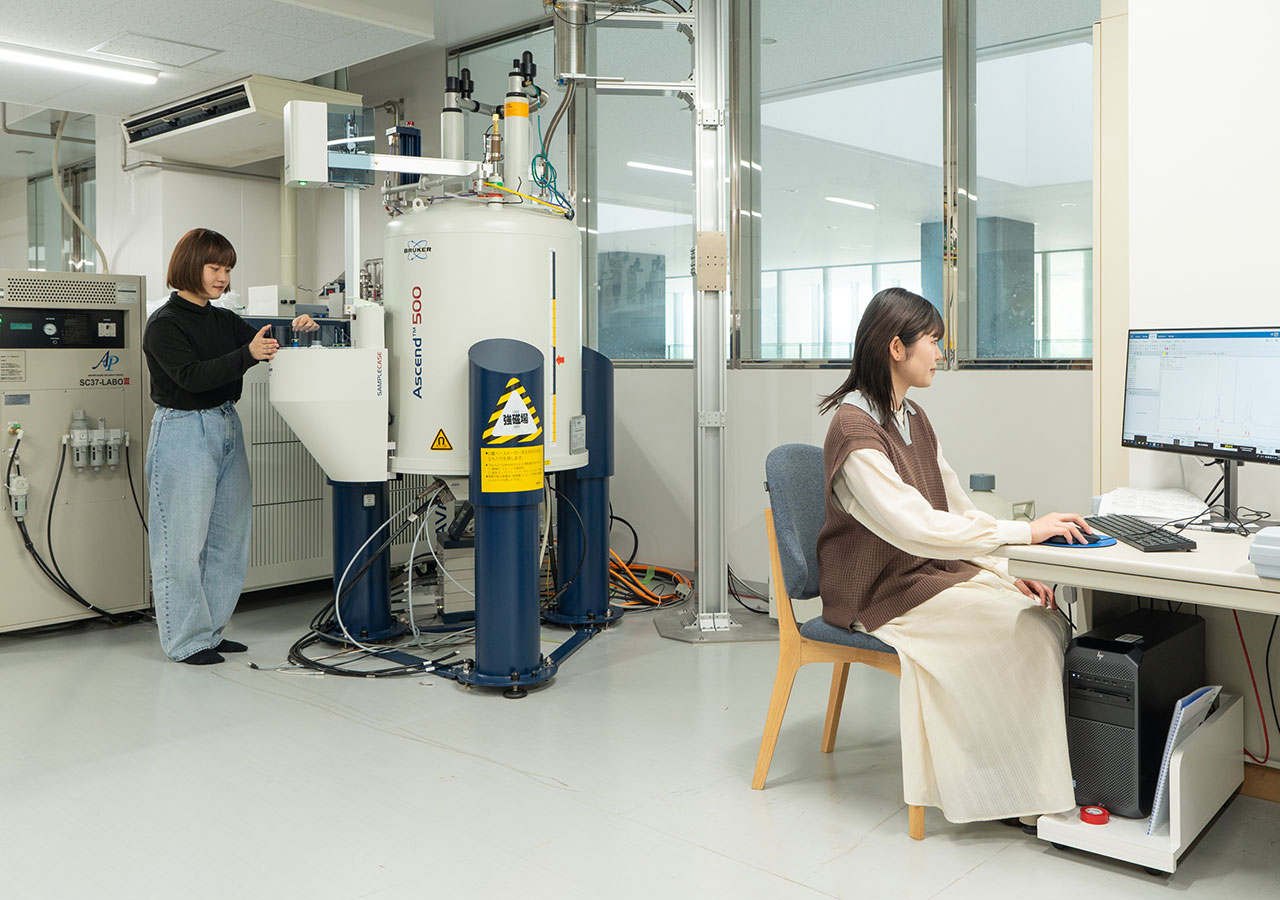
Spectrochemistry(Onda Lab.)
Our research interests are in the area of ultrafast spectroscopy of chemical reactions. Chemical reactions are the phenomena that materials are changed into other materials and their processes occur in the temporal range from femtosecond (10−15 sec.) to millisecond (10−3 sec.). Using ultrashort pulse lasers, we develop various types of time-resolved spectroscopy systems and investigate various functional materials, such as artificial photosynthesis and organic electronic devices, in-situ and in realtime.
Staff
- Ken Onda (Professor)
- Kiyoshi Miyata (Associate Prof.)
- Tomohiro Ogawa (Assistant Prof.)
- Tatsuya Yoshida (Project Assistant Prof.)
Main research topics
- Real-time measurement of photochemical processes and elucidation of their mechanisms
- Elucidation of the mechanism of the expression of the function of organic aggregates that exhibit optical functionality
- Construction of a new device to analyze the dynamic function of excited states using ultrashort pulsed lasers
- Creation of new functional complex materials using typical elements
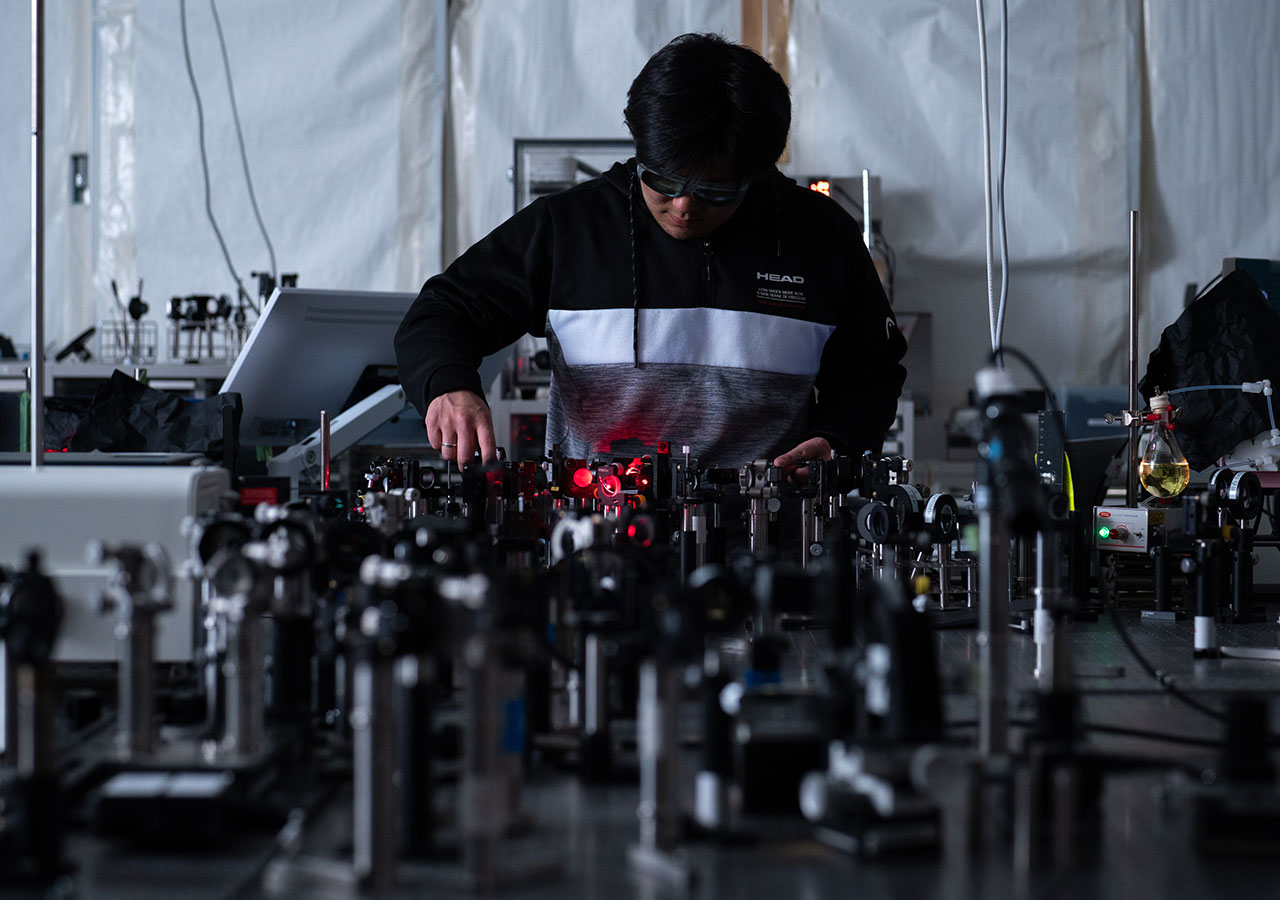
Inorganic Reaction Chemistry(Utsunomiya Lab.)
The aim of my research is to understand the fundamental processes involving nanoparticles in various environmental problems that currently occur on the Earth surface. Specifically, I am interested in the property and behavior of natural and engineered nanoparticles in the ambient environments, their interaction with biological material such as microbes and human respiratory system, and geochemical and biochemical behaviors of toxic elements including radionuclides. Research topics frequently expand to nuclear waste management and atmospheric pollution.
Visit our web site,http://www.scc.kyushu-u.ac.jp/ircl/utu-e/index-e.htm, for further information!
Staff
- Satoshi Utsunomiya (Associate Prof.)
Main research topics
- Environmental Survey Research on the Fukushima Daiichi Nuclear Power Plant Disaster
- Clarification of reaction mechanisms involving radioactive particles during the Fukushima Daiichi Nuclear Power Plant disaster
- Understanding of various environmental problems of the Ningyo-Toge uranium mine contamination
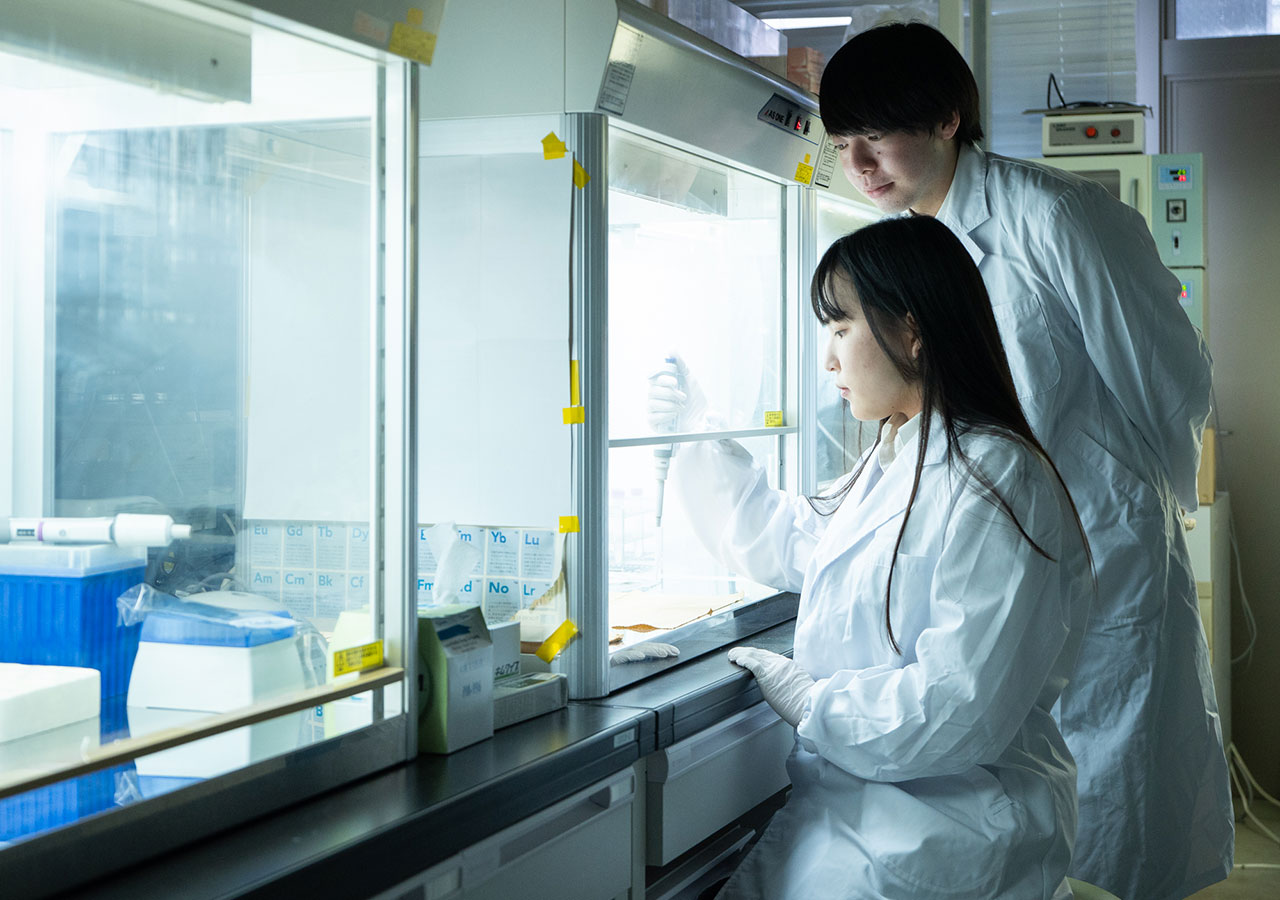
Physical Chemistry
Physical Chemistry of Soft-matters(Annaka Lab.)
We study the physical chemistry of soft condensed matter, which are easily deformable by external stresses, electric or magnetic fields, or even by thermal fluctuations. These materials typically possess structures which are much larger than atomic or molecular scales; the structure and dynamics at mesoscopic scales determine the physical properties of these materials. The goal of our research is to probe and understand this relationship. We study both synthetic and biological materials; our interests extend from fundamental physics to technological applications, from basic materials questions to specific biological problems.
Staff
- Masahiko Annaka (Professor)
- Yasuyuki Maki (Associate Prof.)
- Shintarou Yashima (Assistant Prof.)
Main research topics
- Structure, Physical Properties, and Functions of Amphiphilic Polymers and Polymer Gels
- Structure and Physical Properties of Bio-derived Polymer Gels
- Sliding Friction of Polymer Gels
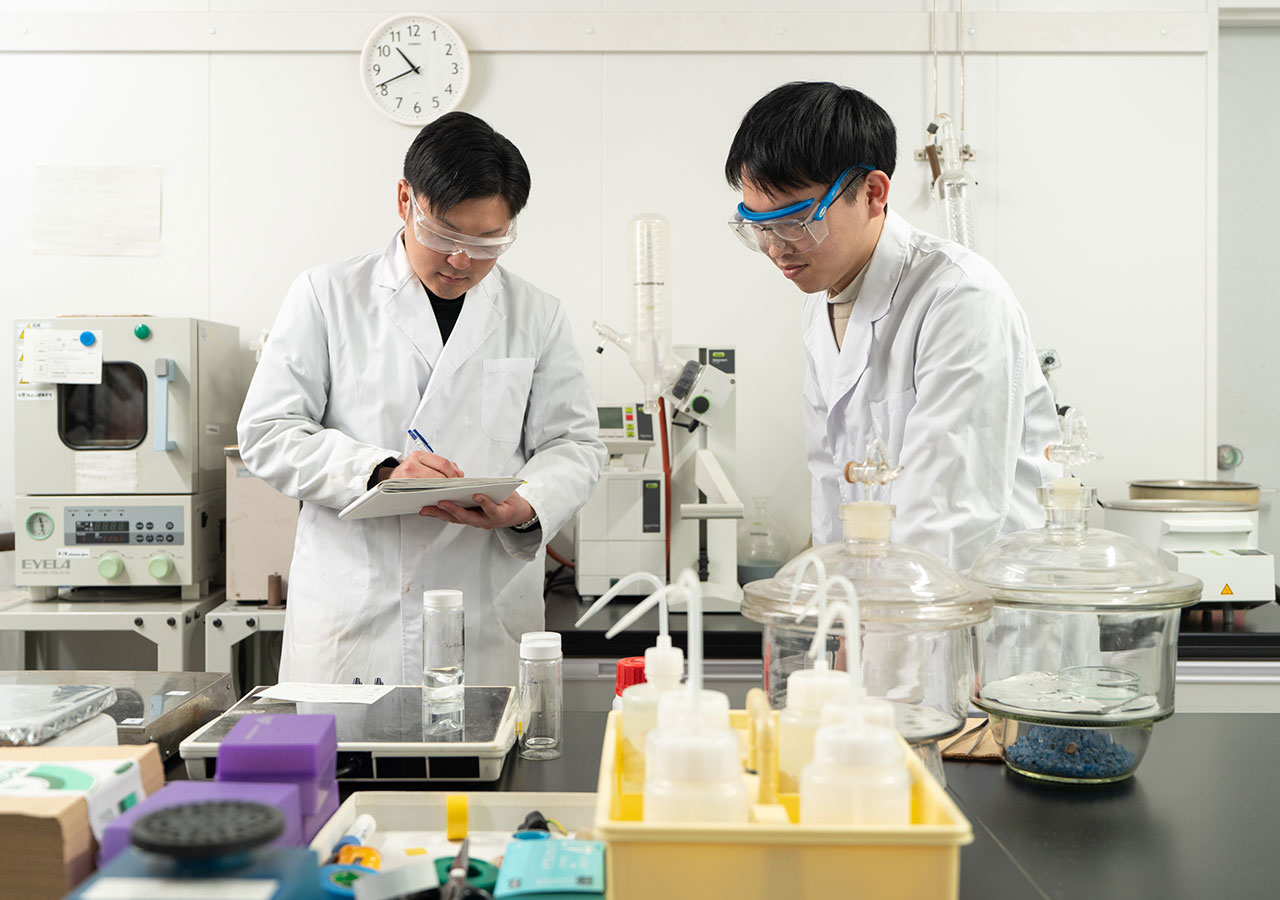
Theoretical Chemistry(Nakano Lab.)
Researches of our group is devoted to the theoretical chemistry based on the first principles of quantum and statistical mechanics. Our main research objective is to develop theoretical methods for electronic structures, properties, and chemical reactions of molecules, clusters, and molecular assemblies. Our focus is especially on the electron correlation theory for molecular systems, molecular theory of solvation, and relativistic molecular orbital theory. We develop mathematical methods, algorithms, and computer software, and approach various interesting chemical phenomena such as solvatochromism, co-solvent effects, and pKa of drug molecules.
Staff
- Haruyuki Nakano (Professor)
- Hiroshi Watanabe (Associate Prof.)
- Yoshihiro Watanabe (Lecturer)
- Satoshi Suzuki (Assistant Prof.)
Main research topics
- Theoretical Research on Complex (Multi-configuration) Electronic States of Molecules
- Theoretical Research on Precise Electronic States Including Relativistic Effects
- Elucidation and Design of Molecular Functions Based on Electronic State Theory
- Development and Application of Dynamic Simulation Methods for Solution Systems
- Research on Quantum Computing Algorithms for Chemical Computation
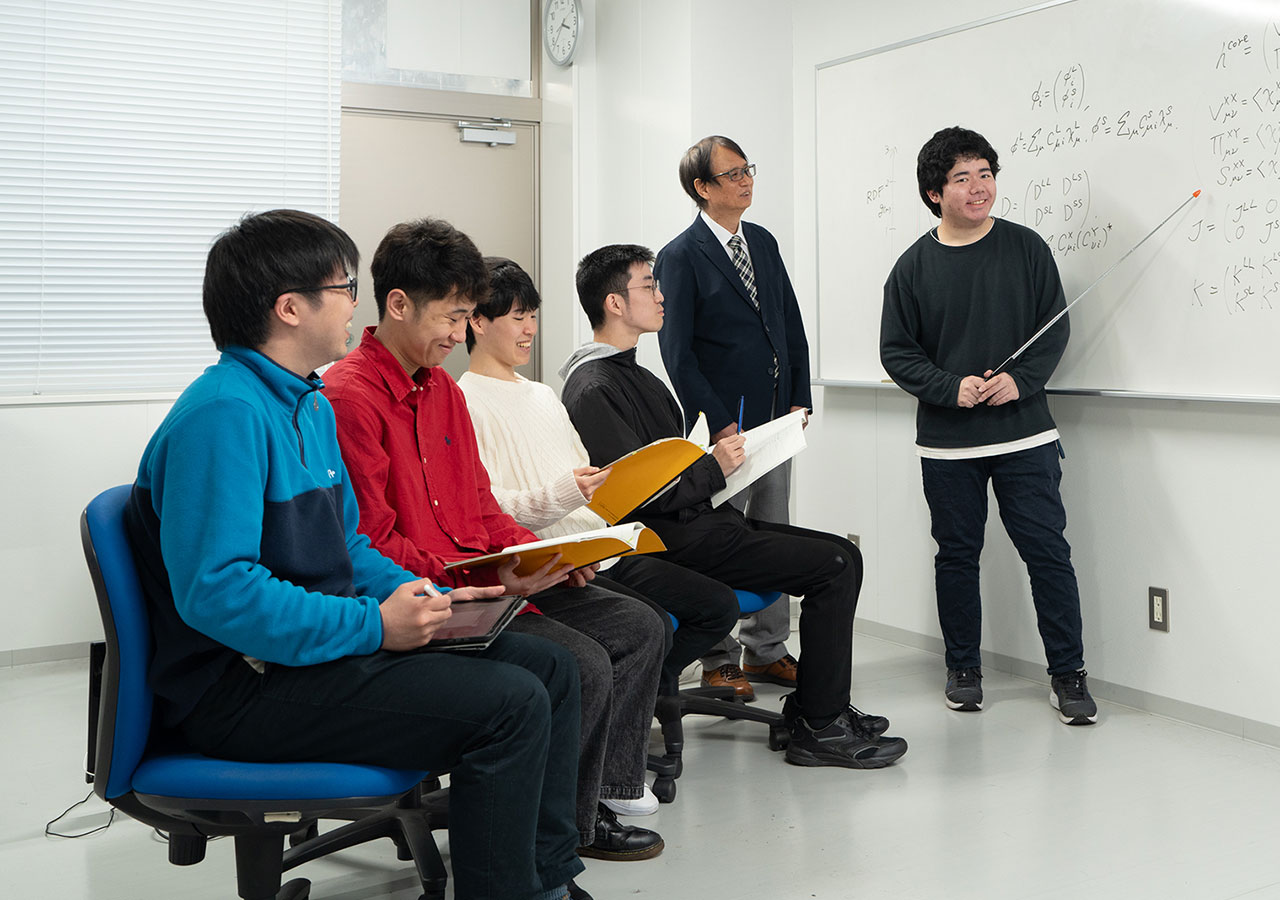
Quantum Chemistry(Terasaki Lab.)
Atomic and molecular clusters offer a unique opportunity to elucidate how physical and chemical properties of a matter emerge as atoms and molecules associate together one by one. We are interested, for example, in how ferromagnetism emerges for iron, cobalt, and nickel among 3d transition metals, whereas other elements do not exhibit it. For another example, silver nanoparticles are known to show strong photoabsorption, so-called surface-plasmon resonance, which is technologically important in coupling light with materials. However, one does not know how this picture works for small particles less than 1 nm in diameter. Furthermore, clusters provide a model of catalysts to gain molecular-level insights into mechanism of chemical reactions. We tackle these problems in materials science with single-atom precision toward advanced nano-science and technology.
Staff
- Akira Terasaki (Professor)
- Takuya Horio (Associate Prof.)
- Ryosuke Oketani (Assistant Prof.)
Main research topics
- Structural Research: Is the structure simply a cut-out of solid metal?
- Electronic Research: What kind of electron shells are formed?
- Reactivity Research: Do inert metals become highly active when reduced in size?
- How do properties change with the number of atoms and combinations of elements?
- Liquid in Vacuum Research: How many seconds does a water droplet take to freeze? At what temperature does it freeze?
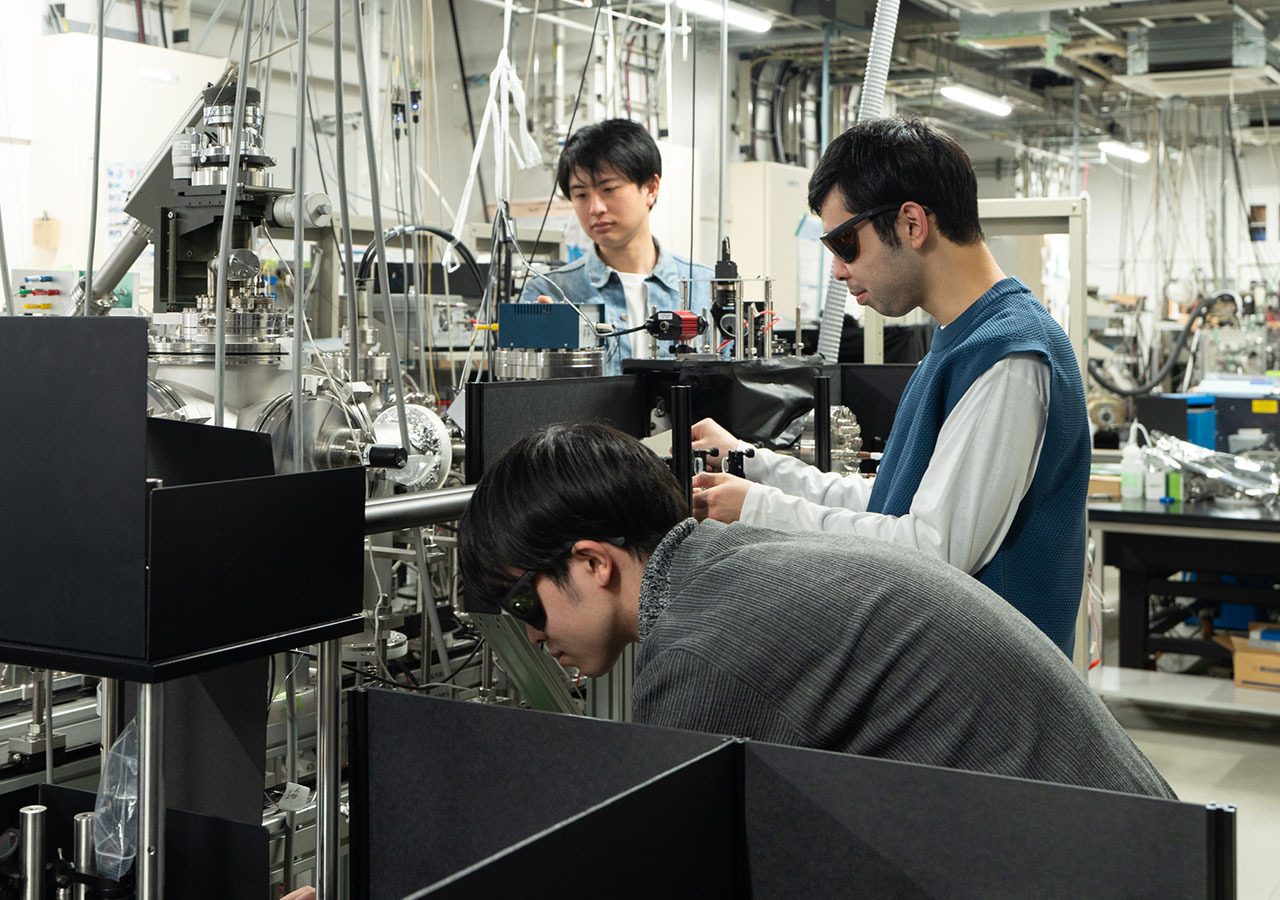
Structural Chemistry(Ohashi Lab.)
Molecular clusters and cluster ions are useful model systems for investigating intermolecular interactions at the microscopic level. Our group has been studying structures and dynamics of molecular clusters and cluster ions through spectroscopic experiments and theoretical calculations. Currently, we focus on the interaction between metal ions and solvent molecules. Our research subjects include (1) coordination and solvation structures of transition metal ions, (2) cooperation and competition between metal ion–solvent and solvent–solvent interactions, (3) comparison of coordination numbers between ions in the gas phase and in bulk solutions, (4) temperature effects on prevalent structures of solvated metal ions, (5) interaction of metal ions with biologically relevant molecules, and so forth.
Staff
- Kazuhiko Ohashi (Associate Prof.)
Main research topics
- Research on the interactions between biomolecules and metal Ions
- Research on the effects of solvent on solute molecules
- Research on various reactions induced by light-absorbing molecules
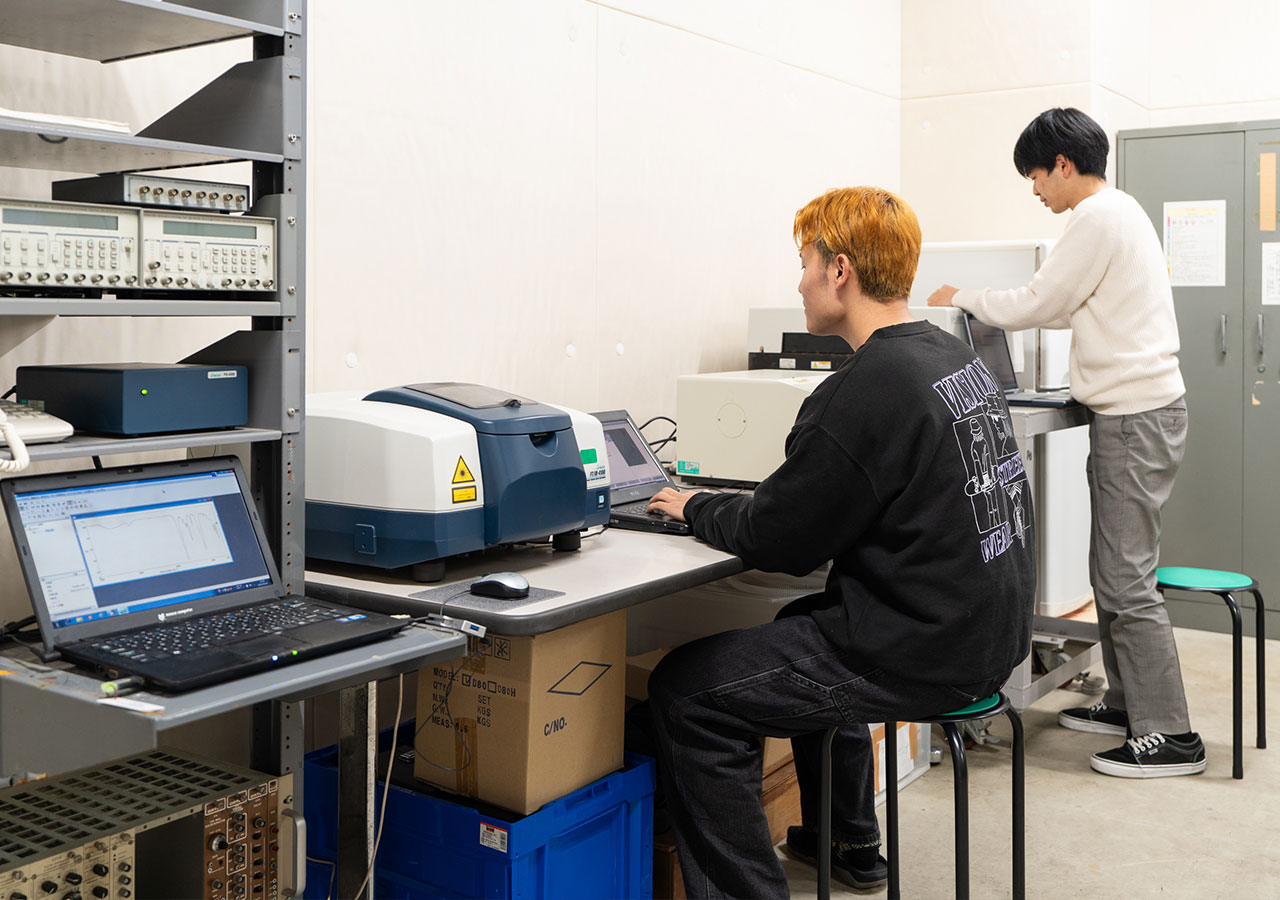
Photo Physical Chemistry(Hiramatsu Lab.)
We are working toward the development of novel spectroscopic techniques for live-cell and in-vivo imaging using “molecular fingerprint”, which are obtained by Raman scattering. One of our goals is to apply these techniques to clinical pathology and disease diagnosis.
Staff
- Kotaro Hiramatsu (Associate Prof.)
Main research topics
- Development of molecular imaging techniques using nonlinear optical processes
- Development of multicolor imaging techniques and their application to super-resolution imaging
- Elucidation of biological functions through big data analysis of spectroscopic imaging
- Ultrafast Image analysis using optical computing
- Development of simple RNA virus detection methods
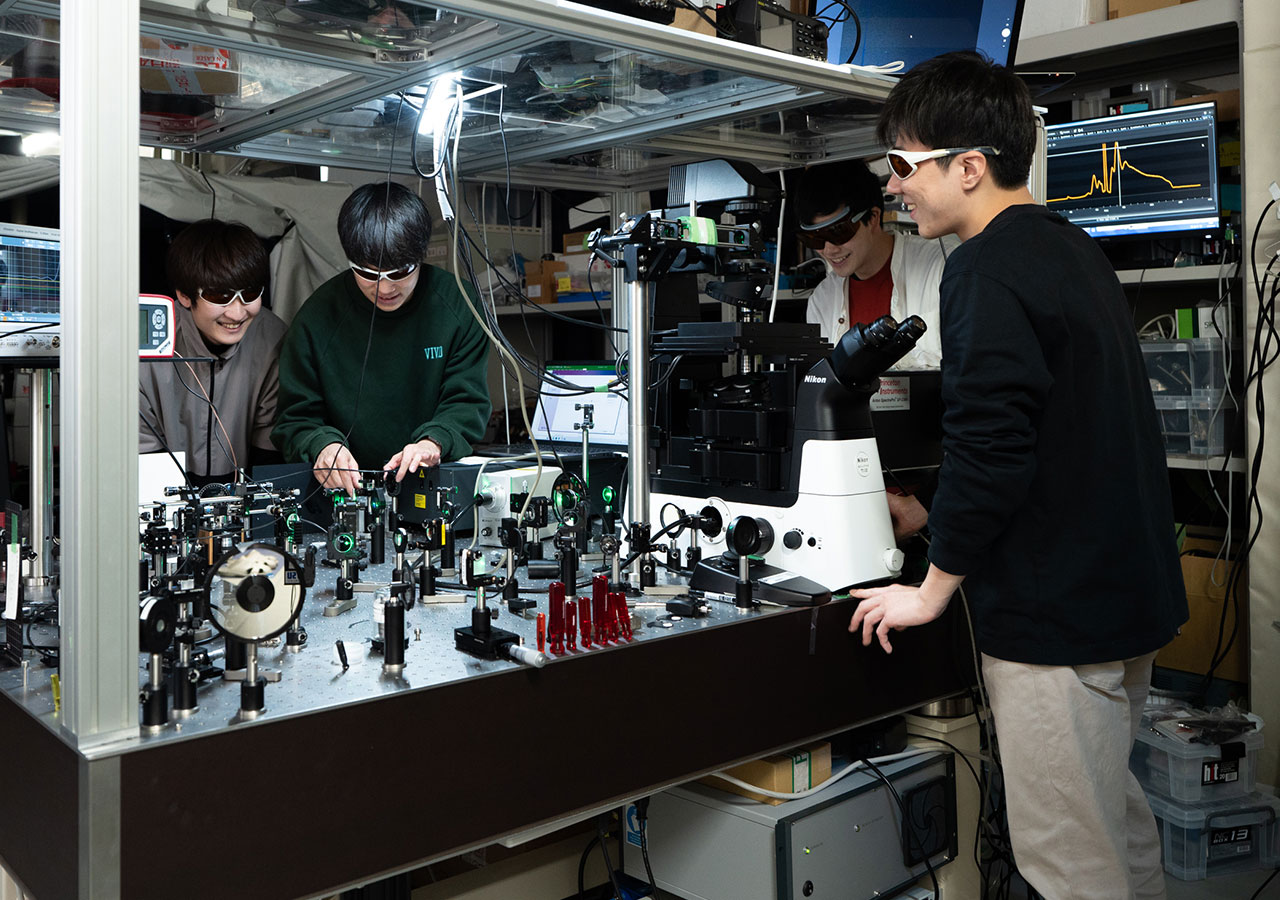
Organic Chemistry and Biochemistry
Molecular Catalysis Chemistry(Tokunaga Lab.)
Our group studies both on homogeneous and heterogeneous catalysis. Particularly, as homogeneous catalysts, we have applied chiral quaternary ammonium salts for asymmetric ester hydrolysis for the first time. On the other hand, supported noble metal nanoparticles are investigated for heterogeneous catalysis. We are developing a novel preparation method of supported Au nanoparticles, reactions for bulk chemical transformation and fine chemical syntheses. In addition, adsorptive desulfurization from beverages and fuels have been investigated.
Staff
- Makoto Tokunaga (Professor)
- Eiji Yamamoto (Associate Prof.)
- Akina Yoshizawa (Assistant Prof.)
Main research topics
- Asymmetric reactions using organocatalysts
- New synthesis of sulfur compounds using solid metal catalysts
- New practical preparation of supported gold nanoparticles
- Practical oxidation and reduction reactions using heterogeneous metal catalysts and simple reactants
- New selective desulfurization method from alcoholic beverages
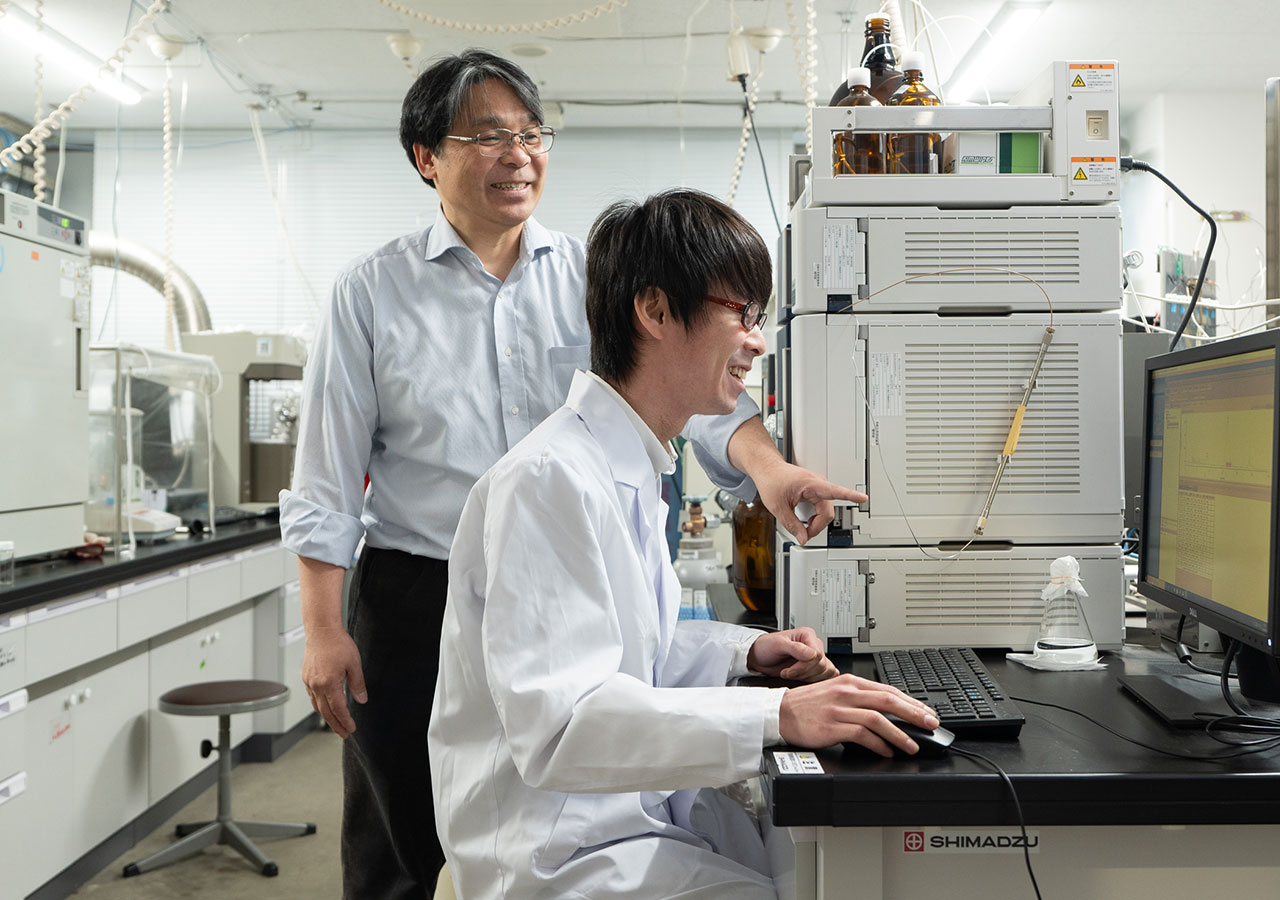
Bioorganic Chemistry(Oishi Lab.)
Interesting organic compounds called as natural products isolated from animals, plants, and microorganisms elicit potent biological activities by acting against cell membranes and certain proteins, and utilized as antibiotics and anticancer drugs. Our group studies about structure determination and total synthesis of bioactive natural products, elucidation of their target proteins and mode of action, and chemical biology based on design and synthesis of bioactive molecules.
Keywords: Natural Products, Biosynthesis, Structure Determination, Organic Synthesis, Total Synthesis, Chemical Biology
Staff
- Tohru Oishi (Professor)
- Yoko Yasuno (Assistant Prof.)
Main research topics
- Chemical synthesis, structure determination, and mechanism of action of ladder-shaped polyether natural products
- Total synthesis and structure-activity relationship studies of natural products with antifungal and anticancer activities
- Development of efficient synthetic methods and their application to natural product synthesis
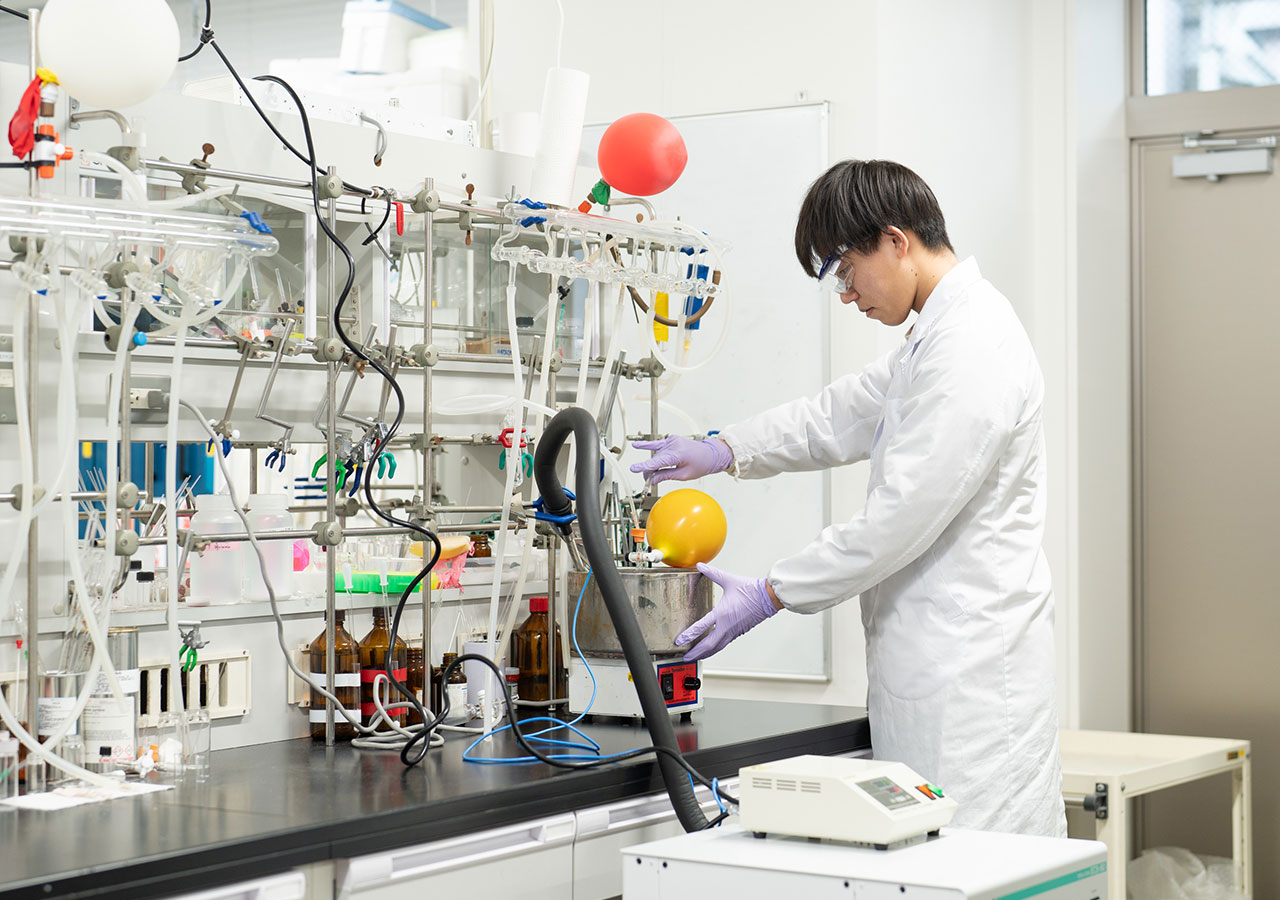
Dynamic Chemical Life Science(Hori Lab.)
In our laboratory, we are developing chemical biology techniques to label and visualize proteins with synthetic fluorescent molecules by devising and applying chemical principles. In living cells, countless biomolecules exist, dynamically changing their localization and controlling cellular events by performing the biomolecular functions in a subcellular region where they are needed. Visualization of the movement of these biomolecules provides important information to elucidate the physiological functions they control. We have developed original technology for fluorescent labeling of proteins to reveal how proteins move in living cells and regulate biological phenomena. Furthermore, we aim to elucidate biological phenomena regulated by nucleic acids, glycans, and extracellular vesicles in addition to proteins, and to control functions of biomolecules and cells at will by making full use of our protein labeling technology.
Staff
- Yuichiro Hori (Professor)
- Kanae Yumimoto (Associate Prof.)
- Junya Adachi (Assistant Prof.)
Main research topics
- Development of protein labeling technology using PYP tags and synthetic fluorescent probes
- Elucidation of the regulation mechanism of GLUT4 dynamics by protein labeling technology
- Development of fluorescent probes for visualization of protein degradation
- Visualization of nucleic acid modifications by hybrid probes
- Development of fluorescence switching probes for super-resolution imaging
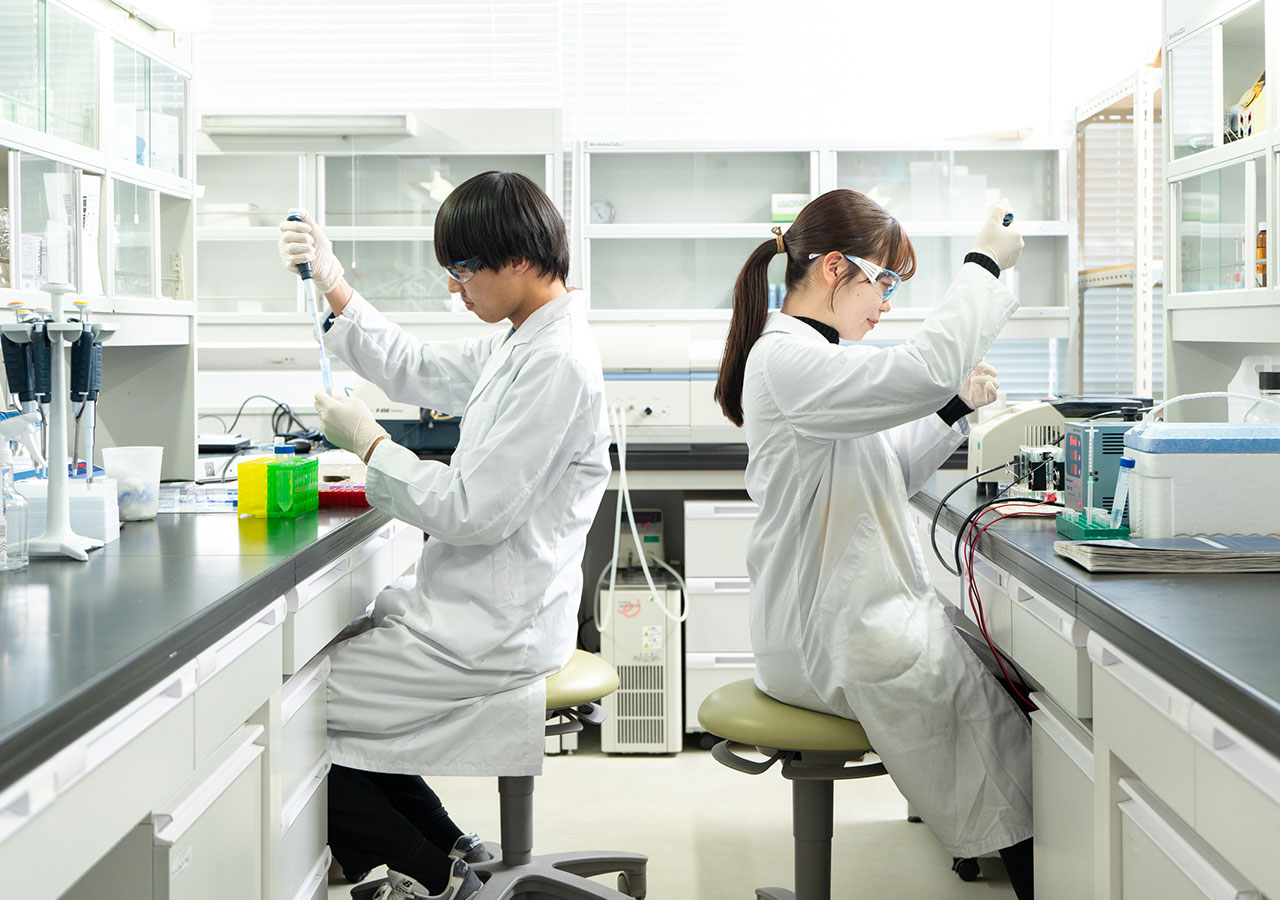
Chemical Physics and Biophysics(Akiyama Lab.)
Various chemical and biological phenomena, such as molecular motor, proteins’ association, and electron transfer reaction, are studied on the basis of physics in our group. We are interested in medium effects, such as solvent effects. Those effects have been recognized to be minor. However, media often change the fates of solutes drastically. Actually, proteins work only under certain thermodynamic condition, and stabilities of colloidal dispersion systems are regulated by the system temperature, the salt concentration, and so on. And, those phenomena relate to the biological functions. We are basically interested in those phenomena. Our main tools are thermodynamics, statistical mechanics and numerical calculation by using computers, such as molecular simulations.
Staff
- Ryo Akiyama (Associate Prof.)
Main research topics
- A statistical mechanics-based study of the reentrant behavior of the strong attractive interaction between charges of the same sign in electrolyte solutions and its concentration dependence.
- Study on the separation behavior using the attractive interaction driven by the configuration entropy of particles.
- Simulation study on the large deviation from the Stokes-Soueinstein equation of the diffusion phenomenon of biomolecules
- Simulation study of self-driven particles
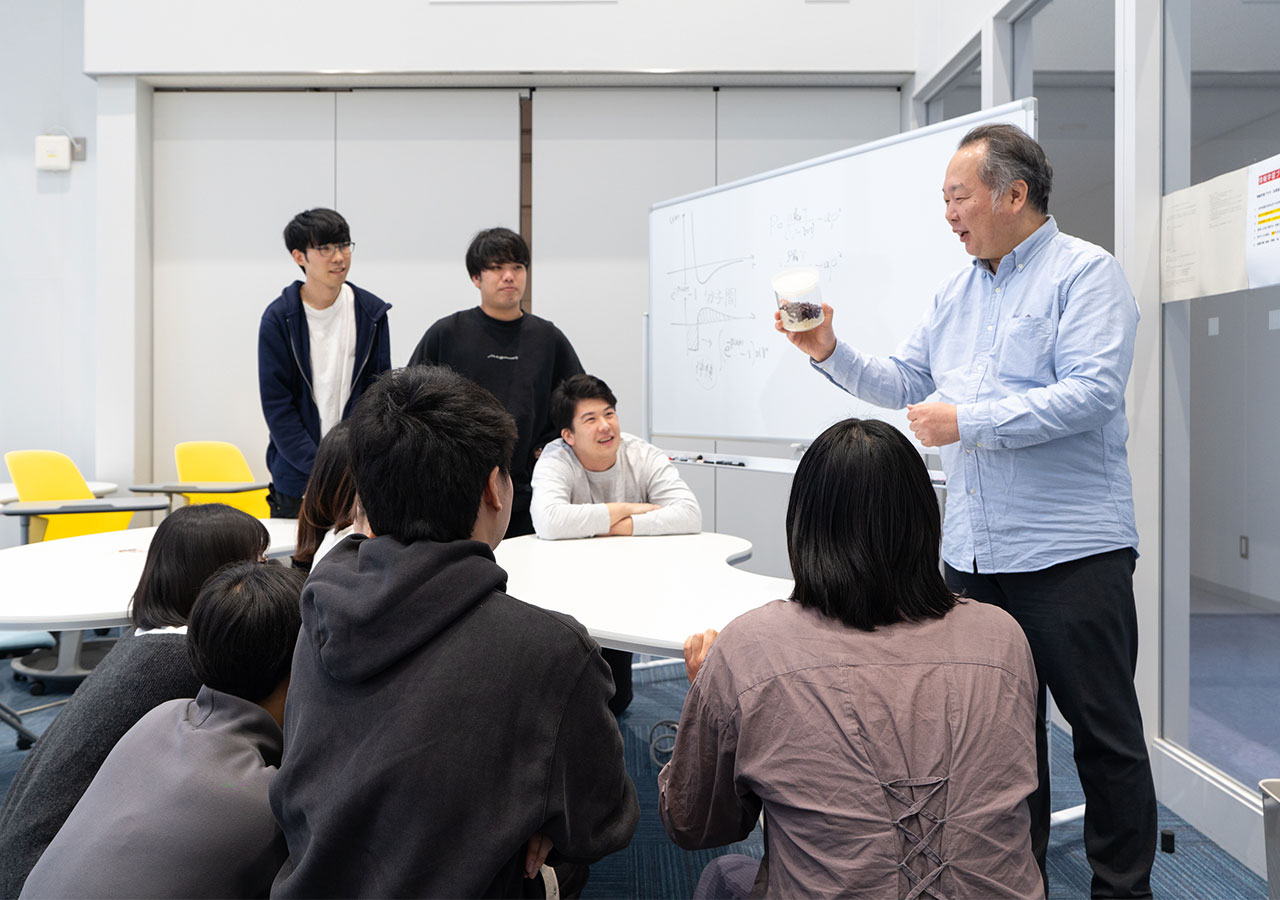
Structure-Function Biochemistry(Matsushima Lab.)
We have a strong interest in the molecular mechanisms of ligand-receptor interaction. There are many kinds of receptors on cell membranes, in the cytoplasm, in nuclei, etc. When a ligand binds to its specific receptor, it induces a conformational change in the receptor’s structure and the signal is then transmitted. Our main research targets are nuclear receptors which precisely regulate gene transcription. We focus on all nuclear receptors to elucidate their activation mechanisms comprehensively. Binding affinity is analyzed in vitro by radioligand binding assays, and transcription activity is measured by reporter gene assays using cultured cells. The other targets are pain-modulating receptors, which are G-protein couple receptors (GPCRs).
Staff
- Ayami Matsushima (Professor)
Main research topics
- Environmental science: Structure-function relationship between environmental chemicals and receptors
- Receptor Chemistry: Structure-function analysis of nuclear and neuropeptide receptors
- Neuropsychology: Analysis of the effects of chemical exposure on behavior
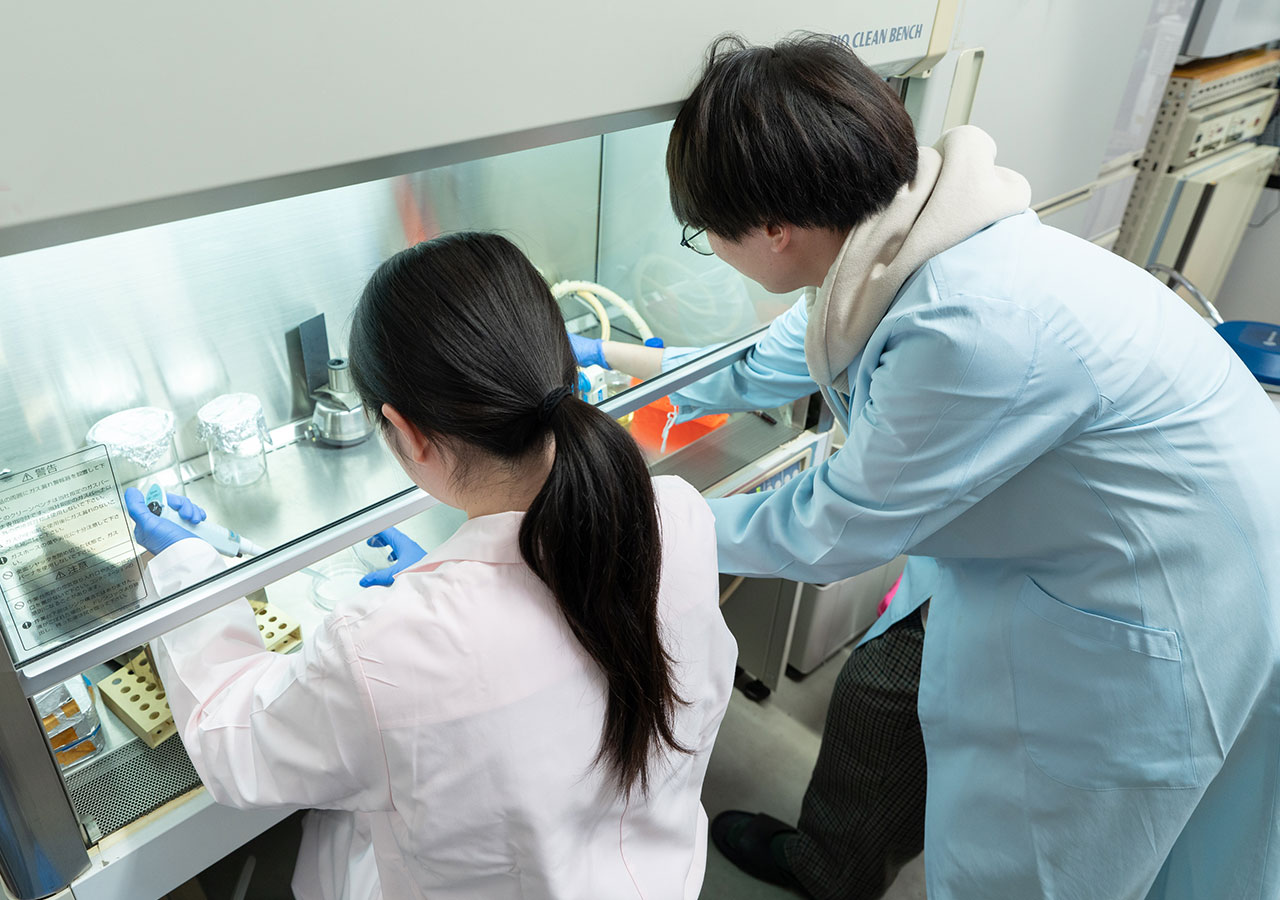
Cooperation Group - Institute for Materials Chemistry and Engeneering
Soft Interfacial Chemistry(Takiue Lab.)
The soft interface such as gas/liquid and liquid/liquid interfaces is regarded as a fundamental structure of soft matters including emulsion, vesicle, biological membrane, and thus the study on the structure and property of soft interface is crucial to understand sophisticated structure-function relation of soft matter. Our group investigates the adsorbed films (Gibbs films) of various surface active substances at soft interfaces by means of macroscopic and microscopic techniques; interfacial tensiometry, synchrotron X-ray reflection (XR), total reflection XAFS, and Brewster angle microscopy (BAM). Our goal is to elucidate the principles of “raft” formation in biological membrane from the viewpoint of “line tension”, which is an excess energy generated at the domain boundary in heterogeneous structure at the interface. Our recent activities are as follows.
Staff
- Takanori Takiue (Professor)
- Mika Matsuo (Assistant Prof.)
Main research topics
Biomolecular Chemistry(Nose Lab.)
Our laboratory mainly studies three subjects that are focus areas in peptide and protein chemistry research. These are as follows: (1) structure-function relationship of elastin-derived peptides; (2) determination and discovery of receptor-binding molecules, in particular, risk assessment of endocrine disruptors using a combination of computational and biochemical techniques; and (3) rational molecular design of enzyme inhibitors.
Staff
- Takeru Nose (Professor)
- Keitaro Suyama (Assistant Prof.)
Main research topics
Synthetic Organic Chemistry(Uchida Lab.)
Organic synthetic reactions are quite important and fundamental technologies for the supplying various materials. However, most of organic transformations are consumed a lot of materials and energies with co-producing undesired waste materials. Development of highly selective, atom-economic and environment-friend new methodologies have been strongly required.
For the purpose of these viewpoints, we have intrigued to oxidative catalytic functionalization using high atom-economic oxidant, and achieved that highly enantioselective water-mediated epoxidation using air as an oxidant, and asymmetric nitrene transfer reaction using azide compound as a nitrene source.
Staff
- Tatsuya Uchida (Associate Prof.)
Main research topics
Nanophysical Chemistry(Tamada Lab.)
Our group studies about the interfacial phenomena between metals, metal oxides, semiconductors and soft materials in nanoscale. Our research target is not only to investigate new physicochemical phenomena on cutting edge of interdisciplinary field of science, but also to develop the new concept for future green and bio-technologies. Our topics include (1) Collective plasmon excitation on 2D crystalline sheets composed of Au and Ag nanoparticles, (2) High sensitive biosensor and high resolution bioimaging by use of localized surface plasmons, (3) Surface plasmon enhanced optoelectric devices such as light-emitting diodes (LEDs) and photovoltaic cells.
Staff
- Kaoru Tamada (Professor)
- Yusuke Arima (Associate Prof.)
- Yuto Kajino (Assistant Prof.)
Main research topics
Cooperation Group - Faculty of Arts and Science
Photofunctional Materials Chemistry(Sato Lab.)
The development of functional molecular compounds for use in molecular electronic devices is an important challenge in the field of materials science. Our group aims to synthesize switchable materials with superior physical properties by controlling electron transfer, spin configuration, orbital movement, proton transfer, and molecular orientation in molecular crystals. In particular, we are currently focusing on the development of magnetic, conducting, ferroelectric, and mechanical materials whose properties can be controlled by external stimuli such as light and temperature. These switchable compounds can be used in future applications such as memory devices and optical switches.
Staff
- Osamu Sato (Professor)
- Shinji Kanegawa (Assistant Prof.)
- Shuqi Wu (Assistant Prof.)
Main research topics
Nanofunctional Chemistry(Yamauchi Lab.)
We synthesize nanometer-seized materials to exhibit high functionalities in catalysis, ion conduction, gas storage and magnetics for the realization of sustainable society. Electric structures, compositions and morphologies of the materials composed of alloys and oxides nanoparticles are controlled to achieve highly efficient energy and material conversions. Composite materials of porous coordination polymers demonstrate novel catalytic and ion conduction abilities through cooperative interactions among ligands and metal species. Prepared nanomaterials are applied as a device for electric power charge/discharge, catalytic materials transformation, hydrogen storage and permanent magnetism. Our final goal is elucidation of guiding principles to realize functionalities of materials and demonstration of higher functionalities based on our own principles.
Staff
- Miho Yamauchi (Professor)
- Hirokazu Kobayashi (Associate Prof.)
- Masaki Donoshita (Assistant Prof.)
Main research topics
Structural Organic Chemistry(Tani Lab.)
Synthesis and function of supramolecular structures based on organic p-electron compounds.
Photoinduced electron transfer and high charge mobility in porphyrin-fullerene supramolecules.
Synthesis and photoelectronic properties of novel polycyclic p-electron compounds.
Photomechanical effect and photochemical reaction of aromatic diimides.
Staff
- Fumito Tani (Associate Prof.)
- Kenta Goto (Assistant Prof.)
